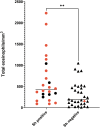Evaluation of the recombinant protein Sh-TSP-2 for the serological diagnosis of imported urogenital schistosomiasis and comparison with commercially available tests
- PMID: 39838901
- PMCID: PMC12088922
- DOI: 10.1017/S0031182024001574
Evaluation of the recombinant protein Sh-TSP-2 for the serological diagnosis of imported urogenital schistosomiasis and comparison with commercially available tests
Abstract
Different agencies have emphasized the need to evaluate current serological methods for screening patients with suspected urogenital schistosomiasis. However, there is still a lack of evidence regarding the most appropriate methods for this purpose. Here we assessed the diagnostic efficacy of a newly developed serological technique that utilizes the recombinant protein Sh-TSP-2, applied to the urine and serum of migrants suspected of having urogenital schistosomiasis. The sensitivity, specificity, positive and negative predictive values of an in-house enzyme-linked immunosorbent assay (ELISA) using the recombinant protein Sh-TSP-2 were analysed and compared with other commercial serological methods. Due to the limitations of microscopy as a perfect reference method, a latent class analysis (LCA) and composite reference standard (CRS) approach was used to determine the sensitivity and specificity of each test. According to the LCA model, the commercial tests NovaLisa® and immunochromatography test (ICT) immunoglobulin G-immunoglobulin M (IgG-IgM) presented the highest sensitivity (100%), whereas the Sh-TSP-2 serum ELISA test had 79.2%. The Sh-TSP-2 urine and serum ELISA tests had the highest specificities among the serological methods (87.5 and 75%, respectively). CRS modelling showed that the ICT IgG-IgM, NovaLisa® and Sh-TSP-2 serum tests led in sensitivity at 97.1, 88.6 and 71.4%, respectively, with all tests except that the ICT IgG-IgM test having a specificity >90%. Sh-TSP-2 has been validated as a screening tool for patients suspected of having urogenital schistosomiasis. Although commercial serological tests have shown higher sensitivities, Sh-TSP-2 could be valuable for confirming results from tests with lower specificity. Nevertheless, further studies with larger patient cohorts are necessary to fully verify its potential.
Keywords: Schistosoma haematobium; diagnostics; migrants; travellers; urogenital schistosomiasis.
Conflict of interest statement
J. S. and A. L. declare that they hold a patent on the use of
Figures




Similar articles
-
Characterisation of tetraspanins from Schistosoma haematobium and evaluation of their potential as novel diagnostic markers.PLoS Negl Trop Dis. 2022 Jan 24;16(1):e0010151. doi: 10.1371/journal.pntd.0010151. eCollection 2022 Jan. PLoS Negl Trop Dis. 2022. PMID: 35073344 Free PMC article.
-
Evaluation of molecular and serological testing for imported urogenital schistosomiasis screening in a referral tropical medicine centre in Barcelona, Spain.Parasit Vectors. 2025 May 30;18(1):196. doi: 10.1186/s13071-025-06832-w. Parasit Vectors. 2025. PMID: 40448125 Free PMC article.
-
Serodiagnosis of imported schistosomiasis by a combination of a commercial indirect hemagglutination test with Schistosoma mansoni adult worm antigens and an enzyme-linked immunosorbent assay with S. mansoni egg antigens.J Clin Microbiol. 2002 Sep;40(9):3432-7. doi: 10.1128/JCM.40.9.3432-3437.2002. J Clin Microbiol. 2002. PMID: 12202589 Free PMC article.
-
Diagnostic Potential of S. mansoni Egg and Worm Antigens for Urogenital Schistosomiasis in Resource-Limited Settings.Parasite Immunol. 2025 Jul;47(7):e70015. doi: 10.1111/pim.70015. Parasite Immunol. 2025. PMID: 40671165
-
The present status of serodiagnosis and seroepidemiology of schistosomiasis.Diagn Microbiol Infect Dis. 1987 Jun;7(2):93-105. doi: 10.1016/0732-8893(87)90026-5. Diagn Microbiol Infect Dis. 1987. PMID: 3115672 Review.
References
-
- Asundi A, Beliavsky A, Liu XJ, Akaberi A, Schwarzer G, Bisoffi Z, Requena-Méndez A, Shrier I and Greenaway C (2019) Prevalence of strongyloidiasis and schistosomiasis among migrants: a systematic review and meta-analysis. The Lancet Global Health 7, e236–e248. - PubMed
-
- Beath KJ (2017) randomLCA: an R package for latent class with random effects analysis. Journal of Statistical Software 81, 1–25.
-
- Beltrame A, Guerriero M, Angheben A, Gobbi F, Requena-Mendez A, Zammarchi L, Formenti F, Perandin F, Buonfrate D and Bisoffi Z (2017a) Accuracy of parasitological and immunological tests for the screening of human schistosomiasis in immigrants and refugees from African countries: an approach with latent class analysis. PLoS Neglected Tropical Diseases 11, e0005593. - PMC - PubMed
-
- Beltrame A, Buonfrate D, Gobbi F, Angheben A, Marchese V, Monteiro GB and Bisoffi Z (2017b) The hidden epidemic of schistosomiasis in recent African immigrants and asylum seekers to Italy. European Journal of Epidemiology 32, 733–735. - PubMed
-
- Bocanegra C, Álvarez-Martínez MJ, Arsuaga Vicente M, Belhassen-García M, Chamorro Tojeiro S, Camprubí-Ferrer D, Fernández Soto P, García Vázquez E, Herrador Ortiz Z, Martín O, Muro A, Pérez Arellano JL, Reguera Gómez M, Salas-Coronas J, Salvador F, Sotillo Gallego J, Sulleiro E, Torrús Tendero D, Velasco Arribas M and Rodríguez Guardado A (2023) Executive summary consensus statement of imported diseases group (GEPI) of the Spanish society of infectious diseases and clinical microbiology (SEIMC) and the Spanish Society of Tropical Medicine and International Health (SETMSI), on the diagnostic and treatment of imported schistosomiasis. Enfermedades Infecciosas y Microbiología Clínica 41, 505–512. - PubMed
Publication types
MeSH terms
Substances
Grants and funding
LinkOut - more resources
Full Text Sources
Research Materials
Miscellaneous

